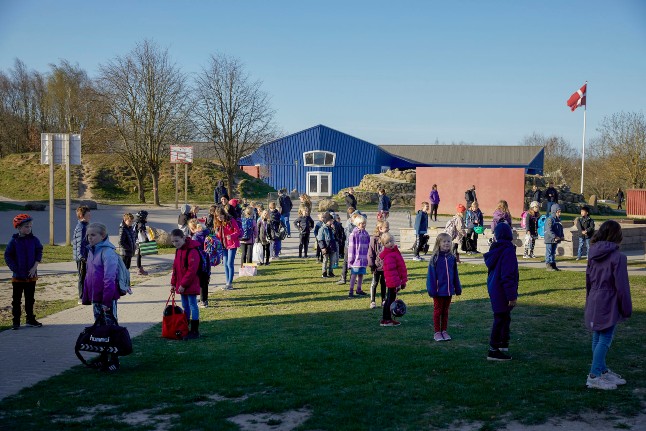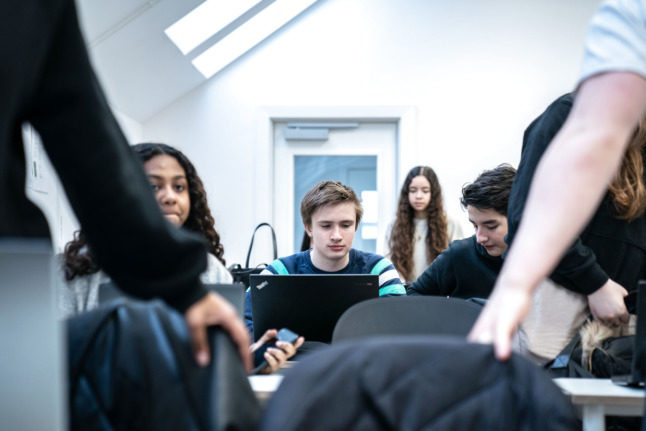SCHOOLS
‘I was crying in fear’: How parents felt about Denmark’s school reopening
There were understandably strong emotions when foreigners in Denmark dropped off their children at schools and kindergartens on Wednesday. But most seemed impressed by the way the authorities handled it, according to The Local's survey.
Published: 17 April 2020 13:49 CEST

Egebakkeskolen in Aarhus opening its doors on Thursday. Photo: Mikkel Berg Pedersen/Freelance/Ritzau Scanpix
The Local on Tuesday asked readers about their experiences dropping their children off at kindergartens and school after nearly a month at home due to the coronavirus lockdown. You can see the results of the survey here.
Some found the new routines strange, others reassuring. But most foreigners who responded seemed to think the whole process went well.
“I was crying in fear,” admitted one parent, who wanted to be anonymous. “I keep thinking they are wrong.”
Maria, from Portugal, said she had had mixed emotions.
“My girl has been happy about the idea of being with her friends (and I guess the routines) again,” she said. “We adults feel that this is a step we need to do, but not without concern and contradictory feelings. After being so careful about distances, isolation, cleaning, and avoiding others, it feels a big step to 'get out' again.”
“All of us have never been so excited…Like the day before a summer vacation!” said Matthew Grey from Canada.
Michael Roche, felt that some of the measures were unnecessary.
“It was very strange and a bit over-kill, and I'm still not sure of the purpose,” he said. “All the rooms were cleaned out to a minimum with just three toys each. We had to bring food for the entire day, leave their spare clothes outside, and they couldn’t bring teddy bears or anything extra from home.”
Good communication
But almost everyone agreed that the communication from their schools and kindergartens, as well from the municipalities and government had been excellent.
“Wonderful! Our school principal sent out a letter of reassurance within 20 minutes of Mette Frederiksen's speech where she said schools were open,” said a dual American-Danish citizen who declined to be named. “We then received regular updates and a very clear plan.”
“The communication from the school was perfect, and gave us confidence and trust,” said Maria. “The video provided for the kids by the health authorities was a very good and positive way of explaining how things will be different, but fun and safe.”
She said she had been comforted by the last minute change in the guidance, which meant that children with someone with coronavirus at home should no longer to school.
“The precautionary adjustment boosted my trust. It's good to know that the leaders are open to accommodate others' concerns.”
Well-organised reception
Schools and kindergartens also got full marks for the way staff received the children.
“It was calm and organised,” said the dual American citizen. “We stood in a line with 2m between each kid/parent and the teachers were waiting for their groups and equally spaced out. Everyone was smiling and ready to give the kids a 'foot-shake' on arrival.”
“We had to drop him at the gate outside where a teacher was waiting at an agreed time, then wash our hands, and then I could take him into the playground,” said Naomi, from the UK. “I talked to the teachers and my son was so excited to be there.”
“There was not such rush what we see in normal days (before shutdown), and teachers were available on the their allocated doors to pick up the students,” said one respondent from India.
“I am extremely positive about it and it went so well this morning and when I picked her up!” said Vaida Hingeberg Pedersen, who is originally from Lithuania.
“Discipline! I actually have missed it, since I was a child and I can say big kudos to parents and children in our school!”
“It was strange, but everything was under control. Precise,” agreed a respondent from the Czech Republic.
What about the Danish parents?
One thing that hadn't changed was the Danish parents, who appear to have been uncommunicative.
“Like usual despite some internal reflection… Danes don't speak so you keep to yourself and look at each other without making eye contact,” Gray said.
“I didn’t speak to other parents, everybody looked cautiously happy but a bit like they were part of an experiment and nobody knew what was going to happen next,” said Naomi from the UK.
Only a partial opening
The only real complaint was that the space constraints have meant that far from all students have been allowed to return, with just half students at some schools and kindergartens given places.
“I got a schedule from the kindergarten where it says that they will split in smaller groups and those groups will come in the kindergarten on chosen dates. My child will visit kindergarten only four days until end of April,” complained Alina Nabokikh, who is originally from Uzbekistan.
“I’m sure this will be phased up over the next few weeks,” said Roche. “I think they are being very cautious and having more thoughts after the announcement.”
Happy children
The group of foreigners who seemed to have the least qualms about the return were the children themselves.
“Child: holidays are over, parent: some peace at last,” summed up Ritch, from the UK.
“My two-year old was so happy to be back he ran off without even saying goodbye,” said another respondent.
“The kids were so delighted to go in so I think that’s the most important thing,” said Roche.
Url copied to clipboard!


 Please whitelist us to continue reading.
Please whitelist us to continue reading.
Member comments